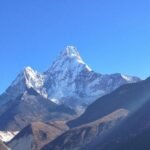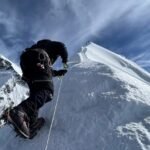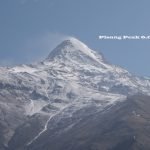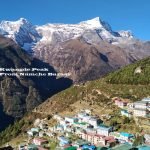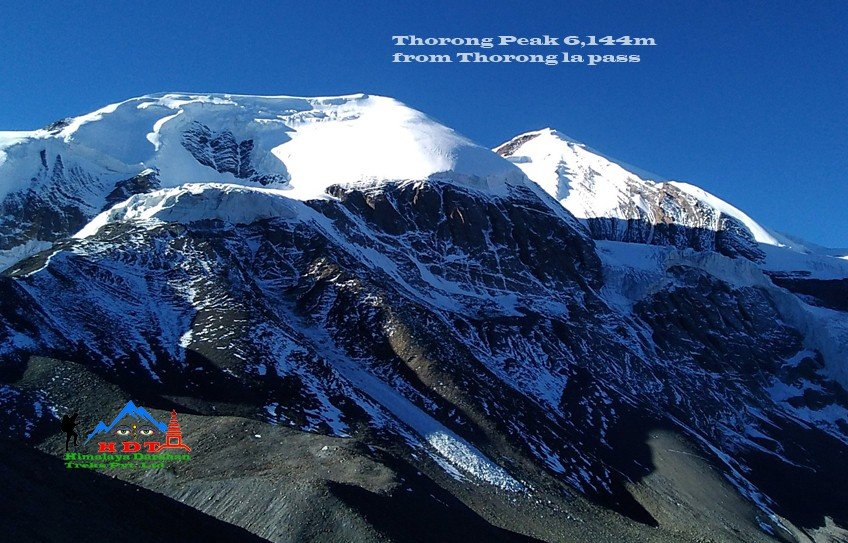

$2250
Per person - All price inclusive
-
Trip Grade:
Challenging -
Max-Altitude:
Summit- 6,144m -
Best Season:
Spring & Autumn -
Trip Mode:
Tea house + Camping -
Group Size:
Min 1+ -
Destination:
Annapurna Region
Thorong Peak Climbing
The Thorong Peak Climbing is one of the most popular and successful adventure programs for adventurers. Thorong Peak is located in the Annapurna Region and is a relatively easy climb. It is not true that prior trekking peak experience is required to climb Thorong Mountain. However, you must be emotionally and physically prepared for this exciting adventure.
Thorong peak is visible above on the approach to the well-known Thorong la pass (5416m). Travel by thousands of hikers every year. Climbing the spectacular but challenging Thorong Peak requires a permit and a qualified climbing guide and going through a registered trekking service in Nepal. Prior knowledge is indeed required to reach the summit.
For this adventurous ascent, you must be spiritually prepared as well as physically fit. This trek will take you to the most breathtaking mountain views, as well as a delightful Gurung and other community hamlets with slate-covered buildings, where you can explore the excellent rhododendron (Nepal’s national flower) jungle, which will give you a variety of emotions.
Thorong Peak Climbing Difficulties
Climbing to the top of Thorong Peak is a challenging job that requires physical strength, skill, and high mountain climbing experience. Here are some of the difficulties that climbers may encounter when climbing Mount Thorong:
Altitude:
One of the biggest challenges mountaineers face when climbing Mount Thorong is the altitude. The top of Thorong Peak is at 6,144 meters, which means that climbers will be exposed to high-altitude conditions for a long time. Thin air at high altitudes can cause altitude sickness, which can be life-threatening if left untreated. Climbers should take appropriate measures to acclimate to the altitude and avoid altitude sickness.
Technical terrain:
Climbing to Thorong Peak Summit involves technical terrain, requiring skill and climbing experience. Climbers will encounter steep rock faces, icy slopes, and narrow ridges during the climb. The use of technical equipment such as ropes, harnesses, and hooks is essential for safe movement over difficult terrain.
Weather:
Weather conditions in the Annapurna Region can be unpredictable and severe. Climbing to Thorong Peak is best during the climbing season, which runs from April to May and October to November. Even during this time, climbers can experience heavy, windy snow and temperatures below zero degrees. Climbers have to prepare for all weather conditions and have the necessary equipment to deal with them.
Fitness:
Climbing Mount Thorong requires good physical fitness. Climbers must be able to walk several hours a day, often at high altitudes and over rough terrain. A good level of cardiovascular fitness, endurance, and strength is essential to completing the climb safely and successfully.
Location:
Climbing Mount Thorong is in a remote location and climbers should prepare to be away from civilization for a few days. Tented accommodation during the climb we have to bring all necessary gear. The remoteness of the location also means that emergency medical assistance is difficult to access in the event of an emergency.
Despite the difficulty, climbing Mount Thorong is a rewarding experience that offers breathtaking Himalayan views and a chance to challenge yourself in a remote and beautiful part of the world.
Thorong Peak Permit Fee
The Permit fee depends on the mountaineering Season. In the spring season, the permit fee is more expensive because it is the best mountaineering season. We need to issue a Thorong Peak Permit from the Tourism Board Department of Mountaineering. The Permit Fee stretchers are:-
- Spring season (March, April, and May) Per Person –USD 250
- Autumn season (September, October, and November) per person – USD 125
- Winter season (December, January, and February) per person – USD 70
- Summer season (June, July, and August) per person – USD 70
Himalaya Darshan Treks highly recommends this Thorong Peak Climbing + Annapurna Circuit Trek. Especially, we provide our best quality service with our very experienced and professional staff. Besides that, we offer many other peak climbing packages. So you can choose your most suitable peak climbing with us.
Thorong Peak Climbing Equipment
We at Himalaya Darshan Treks are highly recommended for good quality equipment for the successful and safe Summit of Thorong Peak. The quality equipment makes your Peak climbing comfortable and safe. Before the climbing, our Climbing Sherpa/guide checks your equipment and assists in how to use this equipment/climbing gear. We always give priority to your safety and the success of your climbing which means you are in safe hands.
1, Clothing:
- Quick-drying shirts and thermal tops and bottoms.
- Fleece jackets or vests
- Down Jacket (Good quality)
- Windproof and Waterproof Jacket (Gore-Tex or similar)
- Rain Jacket
- Fleece or insulated pants
- Waterproof pants to protect from rain and snow.
2, Head Wear:
- Warm hat (wool or fleece)
- Balaclava or neck gaiter
- Sun hat or cap
3, Hand wear
- Lightweight gloves (fleece or wool)
- Insulated gloves or mittens
4, Personal Climbing Gears:
- Climbing Harness
- Crampons (compatible with your boots)
- Helmet
- Ice axe
5, Footwear:
- Mountaineering/Climbing Boots
- Crampons
- Waterproof gaiters
- Thick and warm mountaineering socks
- A pair of slip-on shoes or sandals.
6, Personal Items
- Polarized and UV-protected sunglasses
- Mountaineering goggles
- Sunscreen and Lip balm
- Good quality Headlamp with extra batteries.
- Camera and mobile Charger (Adapter)
- First Aid Medical Kit
- Energy bars (Snacks) lightweight.
7, Essential Items
- Backpack (duffel bag and day bag)
- Good quality Sleeping Bag
- Trekking Poles
8, Drinks/Hydration:
- Insulated water bottle
- Water purification tablets or filter
Note: For the trekking equipment you can check our Trekking Gear List on our website. If you have any confusion or question please contact us or email at himalayadarshantreks@gmail.com. You can also contact us by WhatsApp +9779841073239 for quick response.
Itinerary
Day 1, Arrival in Kathmandu Airport (1,400m) and transfer to hotel
We, Himalaya Darshan Treks heartily welcome you and your group to Nepal. One of our company staff will take you to your hotel in Kathmandu. The person will be waiting outside the baggage hall of the Tribhuwan International Airport, Kathmandu, holding an A4-size paper with your name and our company name. So, you have to look for that person for your pick up from the airport.
Day 2, Sightseeing in world heritage sites in Kathmandu
After breakfast, Sightseeing in world heritage sites such as Swoyambhunath (Monkey temple), Boudhanath, and Pashupatinath then back to the hotel. Meet the Climbing guide (Sherpa) and discuss Thorong peak climbing and climbing equipment.
Day 3, Drive to Besisahar to Jagat (1,300m) Stay at a teahouse
We will begin our trips this morning after breakfast with a drive through the picturesque Nepalese countryside to Bhulbule (850m). Afterward, we will again drive to Jagat (a small hill in the footsteps of Annapurna and Manaslu) by jeep (Full-board accommodation at a tea house)
Day 4, Trek to Dharapani (1,860m). Stay at a teahouse
After breakfast, we’ll take a one-and-a-half-hour rocky trail trek to Chamje hamlet, a small rural population surrounded by bamboo bushes with a primary school. Our adventure continues with a suspension bridge across the Marshyangdi River just after leaving Chamje.
You will view a waterfall, rocky hills, trails, and a little teashop before entering the Manang district soon before Tal village. This is a lovely community on the riverbank with a stunning waterfall view. You’ll cross the river and continue trekking through the cliffs above the river to Dharapani village, where we’ll spend the night. (On a full-board basis, spend the night at a tea house.)
Day 5, Trek to Chame (2,670m) Stay at a teahouse.
Bagarchhap is about an hour’s walk from Dharapani. This lovely village may see the first glimpse of Mt. Annapurna II. On this day, you will pass through a few steep forested landscapes and multiple landslides; nonetheless, keep your eyes out for some spectacular views of prominent Himalayan peaks.
On your way to Chame on this day, you’ll pass through some traditional Tibetan villages (2670m). Chame is Manang’s district headquarters and one of the most picturesque Himalayan settlements, with near views of Mt. Lamjung and Annapurna II. (Full-board accommodation at a tea house).
Day 6, Trek to Upper Pisang (3,300m) Stay at the teahouse..
Another beautiful stroll through a narrow, steep trail that follows the river bank will lead you to the settlement of Bratang, where you can stop for tea. After that, we followed the forested walk and rough trails for an hour before crossing the suspension bridge and arriving at Dhukur Pokhari for lunch.
This little village will see the first view of Pisang Peak and the surrounding Himalayan peaks. After lunch, we’ll walk for an hour to reach our next destination, Pisang hamlet. (Full-board accommodation at a tea house)
Day 7, Trek to Manang (3,540m) Stay at the teahouse.
Today we travel through the drier upper route, which is shielded from the monsoon’s full force by the Annapurna Range. For a portion of the year, the people of this region herd yaks and grow vegetables.
The trail continues from Mungji to adjacent Manang, passing through the scenic but largely hidden settlement of Braga (3475m).
Day 8, Acclimatization Day
In Manang, we spent the day acclimating. We spent the entire day doing beautiful day hikes and marveling at the breathtaking vistas around the village; daytime is the optimum time to gain altitude.
The charming community of roughly 500 flat-roofed dwellings is nestled amid some outstanding landscapes – Annapurna II, Annapurna III (7555m), Gangapurna (7454m) to the south, Tilicho (7132m), and the Grand Barrier to the west, and Chulu West (6583m) and Chulu East (6059m) to the north. We return to our lodging and retire for the night at the end of the day. (Full-board accommodation at a tea house).
Day 9, Trek to Ledar (4,200m) Stay at the teahouse.
After a magnificent exploration of Manang village this morning, we started for Yak Kharka, leaving the route to Tilicho Lake on the left corner and continuing a short hike up to Yak Kharka, a little community nestled at the base of the mountain (4110m). We’ll climb gradually towards a small hill, then turn right behind it to reach Yak Kharka/Ledar (4,200m), where we’ll spend the night. Remind yourself that you can hike up to a small hill for a beautiful view of the surrounding mountains. (Full-board accommodation at a tea house).
Day 10, Trek to Thorong High Camp (4,925m). Stay at the teahouse.
Another short day with views from above takes you to Thorong Phedi’s pass for lunch. A small yet bustling community that caters to the requirements of hikers and climbers. It is located at the base of the Thorong-La, and the trails continue to ascend to the top of the Thorong-La. We trek for an hour after lunch to reach a high camp (4800m) for the night. (On a full board basis, spend the night at a tea house).
Day 11, Trek to Thorong peak Base Camp (5,400m). Stay at Tent/Camping.
It takes 3-4 hours to trek from Thorong peak Phedi to Thorong peak base camp. When you get to Thorong peak base camp, you will have time to recover and prepare for the next day’s ascent. (Full-board accommodation in a tented camp).
Day 12, Thorong Peak Summit (6,144m) and descend to Muktinath (3,800m). Stay at the teahouse.
In the Early Morning, we start to Climb Thorong Peak Summit (6,144m) and trek back to Muktinath (3,800m). (Start to climb around 1:00 a.m., Thorong Peak Summit (6,144m) then trek back to Thorong La top, continue Trek back to Muktinath) Long and hard Day. (Full-board accommodation at a tea house).
Day 13, Trek to Jomsom (2,720m) via Kagbeni village.
Today, we wake up to the beautiful sounds of temple bells and traveled to the Muktinath Temple region, a well-known pilgrimage location. After breakfast, it’s a short walk down to Kagbeni. To Kagbeni, the trail drops through a stunning, arid environment. Kagbeni can be reached only by crossing the Kaligandaki River on both sides.
Perhaps you’ll have lunch in Kagbeni. After a few hours of walking from Kagbeni, we arrived in Jomsom, a large town and the administrative center of Mustang district. It has an airfield above the Kaligandaki River and is a critical settlement in the Kaligandaki area, connecting to Tibet via the ancient Trans-Himalayan Salt Trade route.
Day 14, Flight to Pokhara, Transfer to the hotel
Today we will be taking a picturesque alpine trip to Pokhara, so we must gather our belongings and prepare. The aircraft passes between two high peaks, Mt. Annapurna (8091m) and Mt. Dhaulagiri (8167m), giving us the best views. We have a whole day in Pokhara to appreciate the natural beauty.
Visit the city’s highlights and the surrounding areas sightseeing tour of Pokhara Valley Like Fewa Lake Tal Barahi temple, etc. (On a BB basis, one night at a deluxe hotel).
Day 15, Drive to Kathmandu and transfer to hotel.
Returning to Kathmandu entails a 7-hour trip through the Trisuli River and via numerous towns. You can spend your time relaxing or shopping for souvenirs to take home. In the evening, we will offer a goodbye dinner with cultural dance performances in a traditional restaurant to memorate your incredible journey.
Day 16, Final departure
Today is the last day of this vacation in Nepal; you are saying your goodbyes to the mountains as your tour in Nepal comes to a close today.
But exchange emails with your travel partners and organize your images. You can go shopping or sightseeing if you have extra time. Himalaya Darshan Treks will pick you up from your hotel around 3 hours before your planned flight.
Trip Includes
- Airport pick up and drop by private vehicle.
- 3-night hotel in Kathmandu and 1-night hotel in Pokhara.
- Thorong Peak Climbing permit.
- Annapurna Conservation entry permit.
- TIMS Card (Trekker’s Information Management System)
- Trekking guide, Climbing Sherpa and porters with salaries, food, accommodation, and insurance (1 porter for 2 trekkers).
- 3 times meals (breakfast, lunch, dinner, and one cup of tea/coffee with a meal) during the trekking and climbing.
- Transportation, Kathmandu to Besisahar to Jagat, and Pokhara to Kathmandu by drive.
- All government and local taxes.
- Sightseeing in Kathmandu world heritage sites.
- Garbage deposit of $250
- Flight from Jomsom to Pokhara for guests and guides.
- Staff transportation from Jomsom to Pokhara and Pokhara to Kathmandu.
- First Aid medical kit, Oximeter to check pulse, heart rate, and oxygen saturation at higher altitudes.
- Emergency Helicopter service arrangement (If needed) which will be paid by your Travel Insurance Company.
- We will arrange a Duffel bag, Sleeping bag, Down Jacket, and warm hat (If you don’t have your own.)
- Himalaya Darshan Treks branded T-shirt as a souvenir.
- Annapurna trek map for group
- Thorong Peak climbing achievement certificate. (If needed)
- Farewell dinner with culture program
Trip Excludes
- Lunch and Dinner in Kathmandu and Pokhara.
- Extra night accommodation in Kathmandu and Pokhara than the scheduled itinerary.
- Your expenses (Laundry, bar bills, battery recharge, WIFI, extra porters, bottle or boiled water, hot shower, etc.)
- High Altitude insurance & Helicopter evacuation as well.
- Personal climbing equipment (you can buy and hire the equipment in Kathmandu)
- Tips for Guide, climbing Sherpa and Porter. (Tips are expected)
- Your travel insurance (Necessary).
- Airfare, Kathmandu to Pokhara, and Pokhara to Kathmandu.
- Nepal entry visa fees
- Desserts Sweet things like chocolate, cake, pie, pudding, etc.
- Any other expenses that are not mentioned in the cost include.
Photo Gallery
Responses & Ratings
Related Packages
-
Ama Dablam Expedition - 27 Days
Ama Dablam, also known as Amai Dablang, popularly known as the 'Matterhorn...
- Max-Altitude: Summit 6812m
- |
- Group Size: Min 2+
-
Lobuche Peak Climbing - 18 Days
Are you seeking Lobuche Peak Climbing? and want to get experience climbing...
- Max-Altitude: Summit 6,119m
- |
- Group Size: Min 1+
-
Pisang Peak Climbing - 19 Days
Pisang Peak, at 6,091 meters, is one of Nepal's most beautiful summits....
- Max-Altitude: Summit 6,095m
- |
- Group Size: Min 2
-
Kwangde Peak Climbing - 18 Days
The top of Kwangde In the Khumbu area, climbing is a popular...
- Max-Altitude: 6,012m
- |
- Group Size: Min 2

